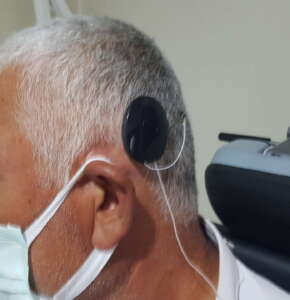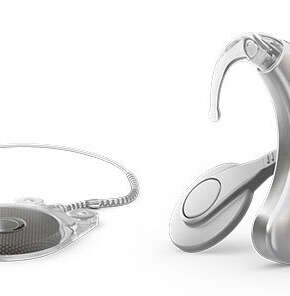What is a cochlear implant?
A cochlear implant is an electronic medical device that replaces the function of the damaged inner ear. Unlike hearing aids, which make sounds louder, cochlear implants do the work of damaged parts of the inner ear (cochlea) to provide sound signals to the brain.
Who can they help?
Cochlear implants can help people who:
- have moderate to profound hearing loss in both ears
- have profound hearing loss in one ear with normal hearing in the other ear
- receive little or no benefit from hearing aids
- score 65% or less on sentence recognition tests done by hearing professional in the ear to be implanted
Many people have cochlear implants in both ears (bilateral). Listening with two ears can improve your ability to identify the direction of sound and separate the sounds you want to hear from those you don’t.
How do they work?
A cochlear implant receives sound from the outside environment, processes it, and sends small electric currents near the auditory nerve. These electric currents activate the nerve, which then sends a signal to the brain. The brain learns to recognize this signal and the person experiences this as “hearing”.
The cochlear implant somewhat simulates natural hearing, where sound creates an electric current that stimulates the auditory nerve. However, the result is not the same as normal hearing.
Many people suffer hearing loss because their hair cells in the inner ear or (or cochlea) are damaged. The cochlear implant enables the sound to be transferred to your hearing nerves and enables you to hear. The process is described below:

- A sound processor worn behind the ear or on the body, captures sound and turns it into digital code. The sound processor has a battery that powers the entire system.
- The sound processor transmits the digitally-coded sound through the coil on the outside of your head to the implant.
- The implant converts the digitally-coded sound into electrical impulses and sends them along the electrode array placed in the cochlea (the inner ear).
- The implant’s electrodes stimulate the cochlea’s hearing nerve, which then sends the impulses to the brain where they are interpreted as sound.
What are the benefits of a cochlear implant?
Many adults with cochlear implants report that they:
- Hear better with a cochlear implant than with a hearing aid
A previous study has shown that people with cochlear implant achieve an average of 80% sentence understanding, compared with 10% sentence understanding for hearing aids1. - Can focus better when in noisy environments
This allows them to have conversations with people across meeting tables, in restaurants and other crowded places. - Reconnect with missed sounds that they could not hear before their cochlear implant.
- Feel safer in the world as they can hear alarms, people calling out and approaching vehicles.
- Talk and hear on the phone
- Enjoy music
What factors can affect these benefits?
The benefit of cochlear implants is often different for different individuals. This difference is often due to:- how long they have had hearing loss before receiving a cochlear implant
- how severe their hearing loss is
- condition of their cochlea (inner ear)
- other medical conditions
- how much practice they include in everyday life when using their cochlear implant system.


















